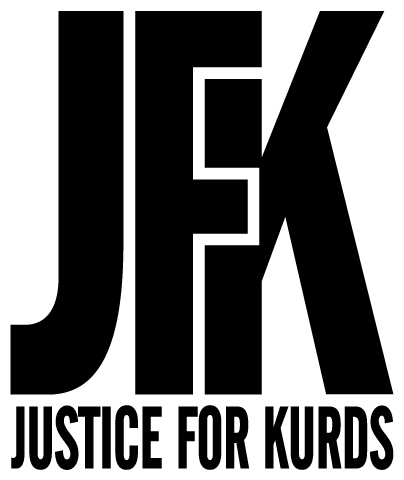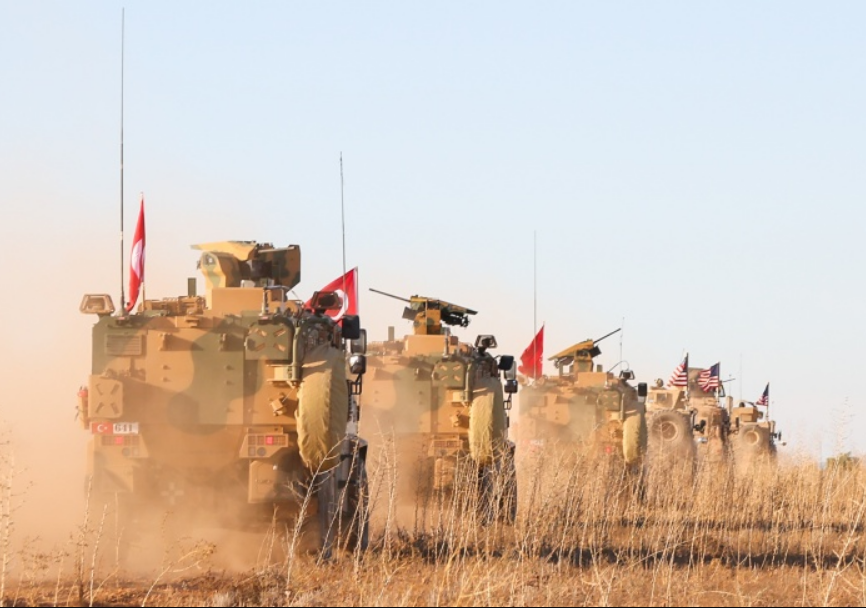Turkey’s latest incursion into Syria is the latest part of a broader strategy Ankara has been implementing in northern Syria. This strategy is one of incrementally dividing and invading Syria’s Kurdish regions in a series of cross-border operations that all have a clear end goal of dismantling the de-facto autonomy that has existed in these regions for the last 8 years.
In 2012, the Syrian military withdrew the bulk of its forces from the country’s Kurdish-majority regions. This gave the Syrian Kurds an unprecedented degree of de-facto autonomy for the first time.
The rapid rise to dominance of the Democratic Union Party (PYD) party, which is essentially the Syrian branch of the Kurdistan Workers’ Party (PKK), in these regions and the sight of their flags along the Syrian border with Turkey were speculated to have given then-Turkish Foreign Minister Ahmet Davutoglu sleepless nights.
Syria’s Kurdish-majority regions were separated for decades preceding the Syrian conflict. This was largely a result of past efforts by the Syrian regime of President Hafez al-Assad to demographically re-engineer or Arabise their regions.
When Syrian Kurdistan (known by Kurds as ‘Rojava’) first attained autonomy in 2012, its regions were consequently separated into three cantons – Jazira, Kobane and Afrin – all across northern Syria.
Following the murderous rise of the infamous Islamic State (IS), the primary armed forces of Rojava, the People’s Protection Units (YPG), garnered US support after they fiercely resisted a ferocious siege by IS on the city of Kobane in late 2014.
With the help of US airpower, they finally broke and repelled the siege in early 2015.
Turkey was alarmed by the US support of the YPG and has invariably argued ever since that the US cannot use one terrorist organization to combat another.
With decisive US air support, the YPG were finally able to link Jazira and Kobane cantons when they captured the Arab-majority Tal Abyad region that sits between them in a large offensive against IS in the summer of 2015.
Turkey opposed the offensive, claiming it was a “direct threat” to its own security. Turkish President Recep Tayyip Erdogan even accused the US-led coalition of bombing Arabs and Turkmens out of their homes and then settling Kurds in their place.
In October 2015, the YPG merged with several other fighting-forces to form the multi-ethnic anti-IS Syrian Democratic Forces (SDF). The group then focused its attention on advancing westward of the Euphrates River, where IS occupied most of the territory situated between Kobane and the far-flung small western Kurdish enclave of Afrin.
Turkey routinely warned that its red line in northern Syria was any YPG presence on the Euphrates’ west bank. Nevertheless, the YPG attained a small foothold in that region in December 2015 when the group captured Tishrin Dam from IS.
Then, in 2016, the US made a deal with Turkey. Ankara acquiesced to an SDF operation west of the Euphrates against the IS-occupied Arab city of Manbij under the condition that the YPG did not retain any foothold there following the removal of IS. The US successfully convinced Turkey to accept the participation of a supporting force of YPG fighters, who it argued were needed given their experience at designating targets for US airstrikes, in the operation.
Throughout the summer of 2016, the SDF engaged IS in brutal urban warfare, suffering several casualties, in Manbij. They finally captured the city from the group by mid-August. The group seemed poised to advance and clear other IS-occupied cities such as Jarablus and Al-Bab soon thereafter. It had even set up military councils to administrate both cities post-IS.
Then Turkey intervened. Mere days after IS were removed from Manbij, Turkey launched its first major cross-border incursion into Syria, Operation Euphrates Shield.
Ankara, using airpower, artillery and armour, backed its proxy force of Syrian militiamen – which later became known as the Turkish-backed Free Syrian Army (TFSA) or Syrian National Army (SNA) – that rapidly captured the border city of Jarablus.
Between August 2016 and March 2017, Turkey captured several towns and villages from IS and, after a lengthy and bloody battle, finally captured Al-Bab further south. Turkey then garrisoned the area with its proxies, effectively blocking the SDF/YPG from advancing any further westward to link-up with Afrin.
The SDF focused their efforts for the rest of 2017 on fighting IS in Raqqa, the group’s de-facto capital, which they successfully captured in October 2017 after months of brutal fighting. The SDF then moved on to destroy the self-styled caliphate’s last territories in Syria’s eastern Deir ez-Zor region – culminating in the complete destruction of the IS caliphate in March 2018 following the capture of the town of Baghouz.
Less than a year after Euphrates Shield was concluded, Turkey invaded Afrin in Operation Olive Branch in January 2018. It heavily bombed the small Kurdish enclave and sent the TFSA on the offensive. The Afrin-based YPG fought for two-months but was unable to prevent the region’s fall. Over 100,000 Kurds were displaced by the invasion and haven’t been able to return to their homes.
In March 2018, the TFSA occupied Afrin city after the YPG withdrew and looted the city in broad daylight. Their prompt resettlement of displaced Syrian Arabs fleeing East Ghouta led to accusations that Turkey seeks to permanently alter Afrin’s Kurdish-majority demographics.
After invading Afrin, Turkey bided its time. It repeatedly threatened to attack Manbij, claiming the deal reached with the US before the operation was not implemented. Ankara also threatened the YPG east of the Euphrates but was not able to launch a large-scale operation given the continued US troop presence there.
The US sought to placate Turkey by introducing the so-called Manbij Roadmap, which saw both militaries patrol the region as part of an arrangement that was supposed to ensure Ankara that no YPG forces were remaining there. Despite this arrangement, Ankara remained unconvinced and unsatisfied.
US President Donald Trump stated he wanted to withdraw US troops, first in March 2018 and then the following December. On both occasions, he walked back on his decision to fully withdraw.
Turkey again threatened major military action against the YPG east of the Euphrates, amassing an enormous force on the border in August 2019. The US promptly rushed to implement a “safe zone” agreement Trump initially put forward the previous January. The US convinced the SDF/YPG to withdraw from key border areas and destroy their fortifications in return to dissuade Turkey from attacking.
Despite joint patrols and helicopter overflights of the region with the US, Ankara remained unsatisfied.
Then in early October, following a telephone call with his Turkish counterpart Recep Tayyip Erdogan, Trump ordered the immediate withdrawal of US troops from the border. Days later Erdogan commenced Operation Peace Spring.
Turkey, again using its TFSA proxies, invaded a large swath of territory between Tal Abyad and Ras al-Ayn, the latter referred to by the Kurds as Sari Kani. While the SDF put up a good fight it knew it could not prevail.
Consequently, the group made a deal with Russia and the Syrian regime, both of which promptly deployed forces, taking advantage of the power vacuum created by the prompt US withdrawal from the border.
Russia and Turkey then reached a deal for joint patrols loosely based on the model the US had implemented shortly before its withdrawal. Turkey has been able to retain its hold over the large 120km-wide swath of territory it has captured to date, which sits directly between Kobane and Jazira.
Its ongoing joint patrols with Russia have also enabled Turkey to send its armoured vehicles through Kobane and other areas, much to the fury of locals who have hurled rocks at them in protest.
In light of the Russian-Syrian presence in northeast Syria, Turkey will unlikely be able to outright invade either Kobane or Jazira anytime soon. Nevertheless, Peace Spring has achieved another major objective in Turkey’s ultimate goal of dismantling the Kurdish-led autonomy in the region.
Syrian President Bashar al-Assad has forces back in the region and has said he plans to gradually dismantle the region’s autonomy, reimpose full control there and gradually disarm the SDF.
Russia and Iran have repeatedly advocated the reimplementation of the 1998 Adana Agreement between Ankara and Damascus, which gave the former the right to target PKK forces using the Syrian side of the border. Ankara will likely settle for the regime retaking control over the area provided it disbands the SDF and YPG, which is ultimately what will likely happen.
To date, consequently, Ankara’s strategy has largely succeeded. It is poised to retain armed forces in Syria until it’s satisfied that the PYD-led polity is history.
On November 8, Erdogan reiterated as much.
“We won’t quit before the last terrorist leaves the region,” he told journalists, in reference to the SDF/YPG. “This is one dimension of the issue. Secondly, we will not quit before other countries leave. We are in favour of Syria’s unity and solidarity. We never want it disintegrated.”
What exactly happens next is unclear. What is clear is that Turkey will continue to exert both military and political capital to bring an end to northeast Syria’s eight years of Kurdish-led self-rule.

